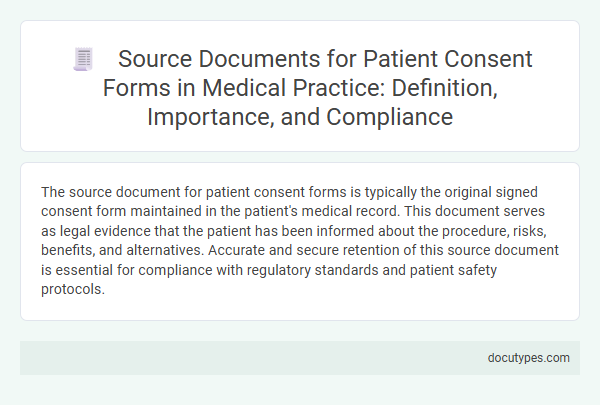The source document for patient consent forms is typically the original signed consent form maintained in the patient's medical record. This document serves as legal evidence that the patient has been informed about the procedure, risks, benefits, and alternatives. Accurate and secure retention of this source document is essential for compliance with regulatory standards and patient safety protocols.
Introduction to Source Documents in Patient Consent
| Introduction to Source Documents in Patient Consent | |
|---|---|
| Definition of Source Document | A source document is an original record containing patient information, serving as primary evidence for medical activities, including consent. |
| Role in Patient Consent | Source documents provide verified data supporting the patient's informed agreement prior to medical procedures or clinical trials. |
| Examples of Source Documents | Patient consent forms, signed agreements, medical charts, electronic health records (EHRs), and clinician notes. |
| Importance in Regulatory Compliance | Ensures adherence to legal and ethical standards by accurately documenting patient consent and protecting patient rights. |
| Initiating Source for Consent | The signed patient consent form itself acts as the primary source document reflecting the patient's voluntary decision. |
| Integration with Clinical Data | Consent source documents frequently link with clinical trial databases and medical records to verify the validity of patient participation. |
| Data Integrity and Traceability | Maintaining source documents supports audit trails and protects data integrity for patient consent processes. |
Defining Source Documents in Medical Context
What is the source document for patient consent forms in a medical context? Source documents are original records containing patient information collected during healthcare interactions. Patient consent forms are considered source documents because they provide verified evidence of a patient's agreement to medical procedures or treatments.
Types of Patient Consent Forms
The source document for patient consent forms is typically the original consent form created by healthcare providers, outlining procedures, risks, and patient rights. These forms act as legal and ethical records ensuring informed consent before medical treatments or interventions.
Types of patient consent forms include general consent, which covers routine care; surgical consent, specifically for operative procedures; and specialized consent for treatments like anesthesia or blood transfusions. Each form details specific information tailored to the procedure type, ensuring patients understand potential risks and benefits. You have the right to review these forms thoroughly before signing, ensuring clear communication and informed decision-making.
Legal and Ethical Importance of Consent Documentation
The source document for patient consent forms is the original signed consent form that captures the patient's agreement to undergo medical procedures or treatments. This document serves as a critical legal record ensuring that the patient understands the risks, benefits, and alternatives involved.
Consent documentation holds significant legal and ethical importance, safeguarding both the patient's rights and the medical provider's responsibilities. Your healthcare provider relies on this documentation to demonstrate compliance with regulations and to uphold ethical standards in patient care.
Key Elements of Valid Consent Forms
The source document for patient consent forms is the original signed consent form completed by the patient or their legal representative. This document serves as legal evidence that the patient has been informed about the treatment, procedure, or research participation.
Key elements of valid consent forms include clear information about the nature and purpose of the procedure, potential risks, benefits, and alternatives. Your consent must be given voluntarily, with the patient fully understanding all relevant details to ensure informed decision-making.
Regulatory Compliance in Patient Consent
The source document for patient consent forms serves as the primary record capturing a patient's informed agreement to medical procedures or treatments. Regulatory compliance ensures these forms meet legal standards to protect patient rights and institutional accountability.
Compliance with regulations such as HIPAA and FDA guidelines mandates accurate documentation and secure storage of consent forms. Proper source documentation supports audit trails essential for healthcare quality and legal protection.
- Legal Foundation - Source documents provide verifiable evidence of patient consent in compliance with healthcare laws and regulations.
- Data Integrity - Maintaining original consent forms ensures accuracy and prevents unauthorized modifications.
- Audit Readiness - Proper source documentation facilitates smooth regulatory inspections and institutional reviews.
Best Practices for Managing Source Documents
The source document for patient consent forms is the original, signed consent form completed by the patient before any medical procedure or participation in a study. Best practices for managing these source documents include securely storing the forms in both physical and electronic formats to ensure easy retrieval and compliance with regulatory standards. Your responsibility is to maintain accurate, organized records while protecting patient confidentiality throughout the management process.
Common Challenges and Solutions in Consent Documentation
The source document for patient consent forms is the original form completed and signed by the patient, which serves as the official record of informed consent. Common challenges in consent documentation include incomplete forms, unclear language, and missing signatures, which can lead to legal and ethical issues. Ensuring accuracy, using standardized templates, and implementing regular staff training are effective solutions to improve the quality of consent documentation.
Role of Electronic Health Records in Consent Management
Electronic Health Records (EHRs) serve as a crucial source document for patient consent forms, ensuring accurate and timely documentation within healthcare workflows. The integration of consent management into EHR systems enhances legal compliance, patient data security, and streamlined access to consent history.
- Centralized Storage - EHRs provide a centralized digital repository for patient consent forms, facilitating easy retrieval and minimizing the risk of lost or misplaced documents.
- Audit Trails - EHR systems maintain detailed audit trails of consent form access and modifications, supporting regulatory compliance and accountability in medical practice.
- Real-Time Updates - Electronic consent management within EHRs enables real-time updates, allowing healthcare providers to verify consent status instantly during patient care.
What Is the Source Document for Patient Consent Forms? Infographic

